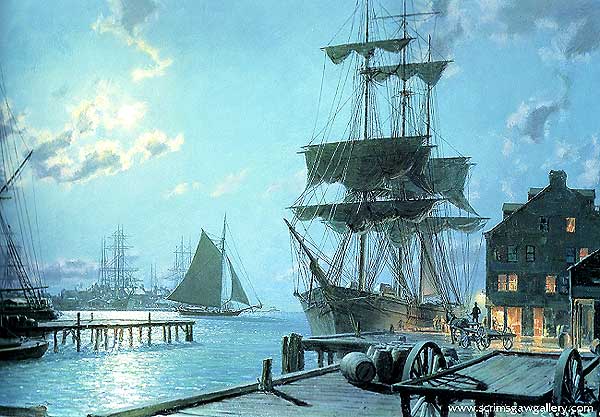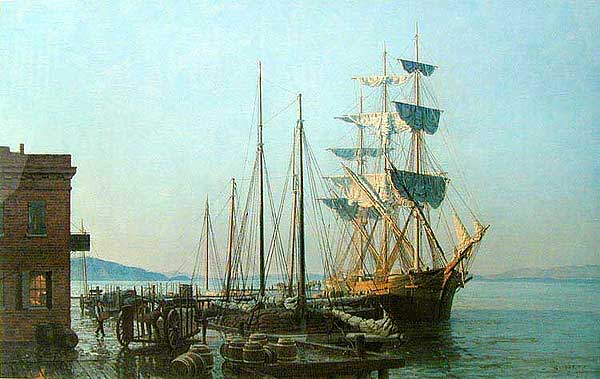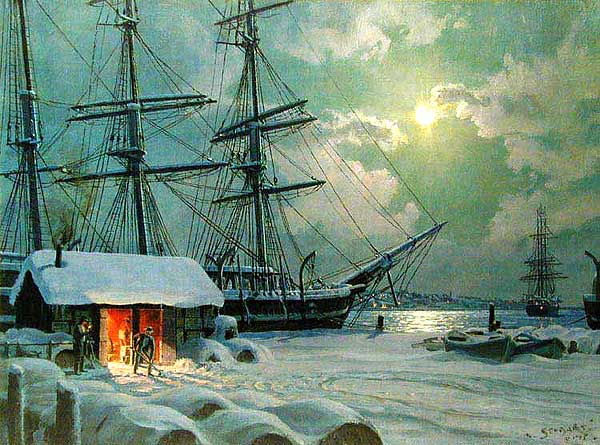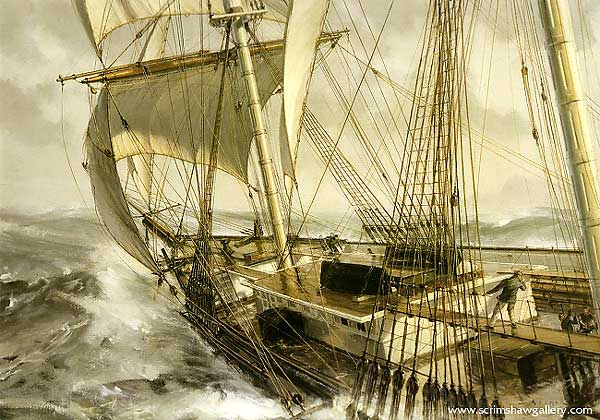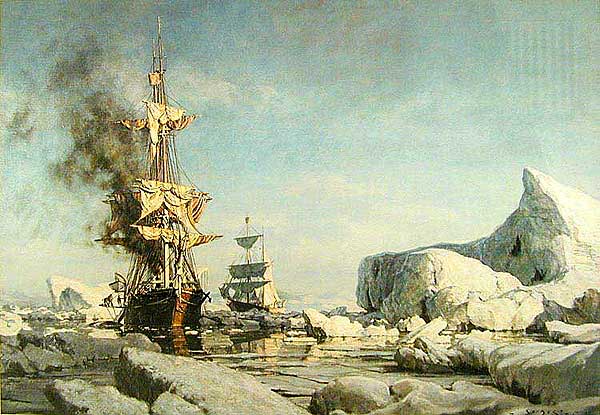Dear Artist,
When I was at the Los Angeles Art Center my friend Tom Bizzini used to say, “Fine art is a sham.” It was a popular sentiment around that workmanlike, survival-of-the-fittest, quality-counts school. In those days it seemed that there were lots of artists who were “putting in a nickel and trying to get a dollar tune.” Same as today.
Recently I saw some of John Stobart’s work in a gallery and was reminded once again just how good he is. John is one of the world’s top marine painters — his work sells in the hundreds of thousands of dollars. He grew up in Derbyshire, England, went to the Derby College of Arts and Crafts, emigrated to Canada and then to the USA.
John’s historical works are loaded with accurate research on vessels long since gone to the bottom — as well as re-visualized buildings and locations. Looking at his paintings, they make me feel like lowering my noble little clinkerbuilt and rowing around in them. To actual happenings in marine lore, he brings an understanding of drawing and perspective, painting bravura, luminous shadows, reflected light, unusual lighting conditions — moonlight, fog, against-the-light, and atmospheric interference. Further, he gets details (such as rigging) right. This is a tough order. John knows how to rig a man-of-war, a Bluenose or a paddle wheeler. Practically everyone who has sailed on any sort of boat will look at a boat painting and find something wrong with it. I overheard one sidewalk expert say: “That block has four holes, it should have five.” The guy was wrong, it needed to be a four-holer, John got it right.
One time John was on our 112-foot vintage tug “Ivanhoe” together with John Horton, another brilliant marine painter. The two studied the giant oak knees that spanned between the ribs and the deck. They looked closely at our scuppers, gunwales, our brass and our carved detail. There was a glint in their eyes — that sobering look that you see when passion is combined with knowledge. New information gives new understanding and new understanding gives new inspiration. This is no sham.
Best regards,
Robert
PS: “Painting from life should never be lost. It should still be taught, respected and practiced. My prayer is that the ancient art of true painting will not disappear, for if it does so much of human nature will perish too.” (John Stobart)
Esoterica: John’s is the classic story of character together with rigorous training at the Derby School, the Royal Academy in London, England, and then emigration to countries (Canada and the USA) that appreciated his skills. Success was more or less instantaneous because quality was there. “I determined I would never call one of my galleries and ask for money,” he says. “I wanted to elevate myself above the status of a starving artist.”
John Stobart
Pirate’s Tale
by Gertjan Zwiggelaar
John Stobart’s work is very inspirational. He is a master who captures the essence of light and water in all kinds of lighting conditions. Incredible, really. For me, seeing the pictures of the sailing ships is especially wonderful because I’m currently writing a new novel titled, A Pirate’s Tale, set in the 18th Century. It is great to see pictures of the types of ships my characters would have encountered.
Suggests detail
by Karen Phinney, Halifax, NS, Canada
John Stobart’s skill is remarkable, particularly his passion for detail. I personally am not a detail person — I like to “suggest” the detail, and do it quickly, where possible. But I do feel tremendously appreciative of folks like Stobart. Right now, despite the bitter cold we have experienced here in Nova Scotia, the upside is… bright, sunny days, with beautiful blue skies! That gives me a lift in the longest dreariest time of the year. Endless cloudy days are a drain at times. I look forward to the letters and the “clickbacks.” Always something to learn, something to share with so many folks, and so many varied ideas and sources.
Seagoing memories
by Georgina Jones
My grandfather was a Master on the old clipper ships that went around Cape Horn. Later he ran a tugboat out of Swansea docks (South Wales, U.K) waiting for tides, and competing with other tugs to reach a ship out in the Bristol Channel, to escort it into the docks. He used to take risks… taking a short cut near the Mumbles lighthouse rocks, in order to beat the other boats. I wish I could talk to my grandfather now. He was originally from Scotland and played the bagpipes. He met my grandmother in Cornwall where the ships picked up copper for export. When the copper ran out they moved to Swansea. My grandmother left Cornwall when she was 18 and never went back. John Stobart’s paintings evoke these memories.
Will figure something out
by Kelly Borsheim, Cedar Creek, Texas, USA
Another letter about quality and also about an artist who made the choice to succeed. Recently, I told a friend that I needed $10,000 to get my next several clay sculptures cast into bronze. I do not have it all yet, but I will figure something out — and quickly too. His response: “Well, you chose to be an artist. You knew then about the starving artists lifestyle.” It has its ups and downs. I soberly answered: I chose to be an artist. That does not mean I have to settle for the cliché of the starving artist. Other people seem to be allowed to love their jobs and make a decent living. I never understand why many artists accept the idea that no one expects artists to be able to do the same.
(RG note) Like Audubon, who had to get money ahead of time for a big project, you might consider collecting a portion of the cost before the art is delivered. It’s been my experience that there are a percentage of folks who rather love to participate in an artist’s dream. It gives them a dream as well, and there are those who don’t have them.
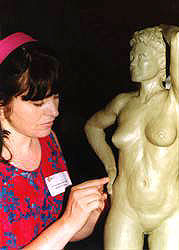
Kelly Borsheim working on Jennifer during a demonstration in Dallas. Kelly worked with the model for 3 hours a week for 8 weeks.
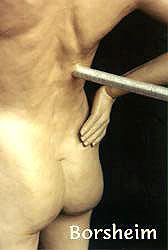
Jennifer close-up: right hand is resting on the hip, but pulled away from the body, causing a lovely shadow.

Jennifer, Bronze with Limestone Base by Kelly Borsheim, Limited Edition of 12, 38 H x 15 x 13 inches
Art a sham
by Jan Zawadzki, Ontario, Canada
All art is a sham… and that it is why it is art. It commits suicide on the wheel of creation. From one moment to the next it follows a belief that it is accomplishing something. Any fool knows this is not so. Any fool must know the dictates of limitation as it applies to him/her personally (B’hais and B’ha’u’la notwithstanding… almost got suckered you did. I like the recovery… most human… otherwise I wouldn’t be talking to you). Why else be in the business? To be famous… horseshit… that only comes because of immediate fashion! It merely accommodates that which is and records it for posterity’s sake. A gifted artist will merely set the parameters. A talented artist will merely go further. A conscripted artist will become a curator… la de da. An artist of his time will only be one when the moment for him/her becomes allowable to be so. Regardless of how many flakes think they can dabble in the exquisite preamble to painting ‘over the couch,’ I’d rather the couch be the reason for having painted in the first place — with a naked woman on it — and not some stupidity that allows for florals — no weather-man, no weather.
(RG note) A vase of flowers is worth a jar of Prozac.
Intelligent choices
by Alison Irwin
My passion is weaving. Recently it seems to be the process itself, rather than the finished product, that fascinates me the most. Often, when I’m asked what I weave, I reply “Samples!” Those small pieces of fabric, however, have a big impact on the cloth that does make it past the experimental stage on my loom. What I learn from creating them means that the ultimate woven product is better than if I’d just plunged in. So I appreciated what you had to say about your two friends and their wise study of your tug. Their approach applies just as much to my craft. I always tell my weaving students that the sample I have them do before they get to weave the more complex stuff allows them to make more intelligent choices about weft, colour and pattern.
Art Center School
by Robin Neudorfer, San Marino, CA, USA
I’m curious if you are speaking of Art Center College of Design in Pasadena? I am an alumnus of ACCD and still to this day I have fond memories of a fabulous experience.
(RG note) When I was there the Art Center College of Design was in Los Angeles. Shortly afterwards they moved the school to Pasadena. Yes, it was a fabulous experience, and I would say tough. It took me only a few days in the first semester to determine that I was the worst artist there. I knew I had to buckle down and get serious in order to stay in. For a while there I gave up girls.
Small world
by Nancy Choate, Brentwood Bay, BC, Canada
My father always spoke of the great John Stobart and had several prints of his hanging in various parts of the house. I always admired the detail and strength of the paintings. I also remember meeting John Horton and am a great admirer of his work. Several times Mel and I were privileged to be on the towboat Ivanhoe.
Dog’s chance
by John Stobart, Ft. Lauderdale, FL, USA
How much we could talk about and how little time there is to spare while searching for that illusive goal at the easel or on site — life’s great masterpiece. Today’s aspiring artist doesn’t have a dog’s chance in the majority of places, and even then, will likely be advised by “teachers” who know nothing whatever of the basics, and drawing and painting, as their skills, if any, are talk, design and decoration which seems to have replaced art.
Societies
by Mary Tod
Historic marine art is a genre of which there are perhaps only about 100 truly proficient practitioners worldwide. Because of the specificity of the subject matter and the mutual need for research, these artists do well to work together under the umbrella of association. Societies promote the collecting of the subject, legitimize it, and improve quality by mutual competition and exhibition.
(Andrew Niculescu note) Societies of Marine Painters are: International, Canadian, American.
Looking for an agent
by Antonio Puri, Tampa, FL, USA
Your links pages are very useful resources for artists. My question is what should an artist be looking for in an art agent and how does one go about finding the right agent? I have not run into anyone real as yet and am thinking about sending a catalog of my works to different agents and publishers around the country. What do you think?
(RG note) A sharp looking, understated catalog is okay. A website with your best foot forward is also useful and can be less expensive in the long run. It has the advantage of going on and on after your brochure has gone to the wastebasket. Plus you can update as work changes or improves. It has become clear over the past few years that an artist’s stand-alone site is now the method of choice and by far the most effective tool. Dealers and agents have written to tell us that they cruise our links for new artists to represent. They need new blood that will fit into their particular stable. When you have your own site, when your name is mentioned or you drop off a card, dealers can find you and size you up at their own discretion.
There is a page that helps define what you should be looking for in a gallery or art dealer: Art gallery evaluation sheet. Other letters and responses on the subject are: Dealing with dealers, How to write a CV and Selling your art.
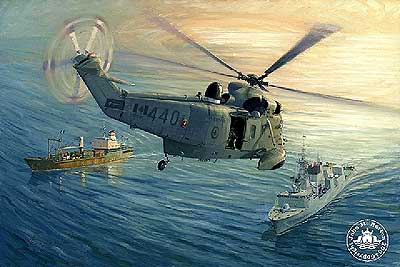
Apollo Patrol Giclee of painting |
You may be interested to know that artists from every state in the USA, every province in Canada, and at least 115 countries worldwide have visited these pages since January 1, 2004.

